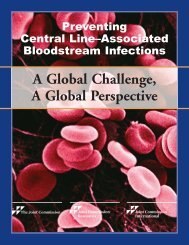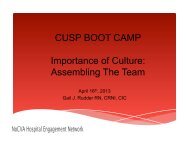Presentation - North Carolina Quality Center
Presentation - North Carolina Quality Center
Presentation - North Carolina Quality Center
You also want an ePaper? Increase the reach of your titles
YUMPU automatically turns print PDFs into web optimized ePapers that Google loves.
NoCVA HAI Learning Network:<br />
A Hospital Engagement Network<br />
Project<br />
February 13, 2013<br />
1
Some Background<br />
• Partnership for Patients<br />
• Hospital Engagement Networks<br />
• Your hospital<br />
2
3<br />
What’s It All About?<br />
http://partnershipforpatients.cms.gov/aboutthe-partnership/what-is-the-partnershipabout/lpwhat-the-partnership-is-about.html
What does this mean?<br />
• Your facility has pledged 40/20 to CMS<br />
• CMS is not dictating how you do this.<br />
• Role of HENs.<br />
• HAI Learning Network is one of the NoCVA HEN models to<br />
help achieve the goal of reducing HAI-related HACs by 40%.<br />
• Even if you decide not to participate in this HEN project,<br />
the commitment to reduce these HAIs by 40% still<br />
exists.<br />
• The pledge taken was to CMS, not to NoCVA HEN.<br />
6
So…<br />
• Review this Pledge with your Leadership<br />
• Participation in the Learning Network will provide important<br />
information from experts and colleagues about HAI<br />
prevention<br />
• Essential to have specific, coordinated work going on in your<br />
facility to put learning into practice<br />
7
HAI Learning Network Background<br />
• All of the HAI HACs were “bundled” together under one “HAI<br />
Learning Network” for 2013--CLABSI, CAUTI, VAE, and SSI<br />
• Allows efficiencies for the participants and NoCVA Leadership<br />
team.<br />
• Allows participants to take advantage of multiple types of learning<br />
opportunities<br />
• SSI prevention content will continue in the Safe Surgery<br />
Collaborative<br />
o 2 groups will share SSI prevention offerings from both projects where<br />
feasible.<br />
8
NoCVA HAI Partners<br />
• Association for Professionals in Infection Control and<br />
Epidemiology, NC and VA Chapters (APIC-NC and<br />
APIC-VA)<br />
• NC and VA Divisions of Public Health (NC and VA DPH)<br />
• The <strong>Carolina</strong>s <strong>Center</strong> for Medical Excellence (CCME)<br />
• Virginia Health <strong>Quality</strong> <strong>Center</strong> (VHQC)<br />
• NC Statewide Program for Infection Control and<br />
Epidemiology (NC SPICE)<br />
9
Leadership Team and Expert Panelists<br />
Name Title Organization<br />
Dr. Zack Moore Medical Epidemiologist NC DPH<br />
Jayne Lee President, APIC-NC APIC-NC<br />
Millie Lavaway 2012 President, APIC-VA APIC-VA<br />
Andrea Alvarez HAI Program Coordinator VA DPH<br />
Connie Jones HAI Program Coordinator NC DPH<br />
Chrystal Adams Care Improvement Specialist CCME<br />
Thelma Baker VP, Care Integration VHQC<br />
Deb Smith Area Manager VHQC<br />
Betsy Albee<br />
2011 President, Current Board Member,<br />
APIC-VA<br />
APIC-VA<br />
Kirk Huslage Associate Director, NC SPICE NC-SPICE<br />
Dr. Carol Koeble Executive Director, NCQC NCQC<br />
10
So, what’s it all about?<br />
• GOAL: Reduce SIR or rate by 40% by<br />
December 31, 2013<br />
• Four prevention focus areas: CLABSI, CAUTI,<br />
VAE, and SSI<br />
o Vertical prevention strategies<br />
o Horizontal prevention strategies<br />
o Sharing of innovative work<br />
• Adaptive focus: CUSP<br />
11
Planned Activities<br />
• Three regional CUSP Boot Camps (each facility is asked to<br />
send at least one representative to one of the Boot Camps)<br />
Two in NC<br />
‣March 20 th in Winston-Salem, NC<br />
‣April 11 th in Fayetteville/southeastern Piedmont, NC<br />
One in Richmond, VA – April 16 th at VHHA<br />
• Four-to-five webinars or networking conference calls<br />
(depends on need and requests)<br />
• One in-person conference at end of 2013<br />
12
Time Line<br />
Timeframe<br />
January and February 2013<br />
March 20 (NC) and April 11 (NC) & 16 (VA)<br />
Activity<br />
Recruitment & Orientation webinars<br />
Three regional CUSP Boot Camps<br />
Action Period March – December 2013<br />
Quarterly<br />
May-November 2013<br />
December 2013<br />
January – June 2014<br />
Data submission<br />
Virtual learning sessions/networking<br />
calls<br />
In-person learning session<br />
Sustainability monitoring<br />
13
What are “Vertical” and “Horizontal”<br />
Prevention Strategies?<br />
14
CUSP: Comprehensive Unit-based<br />
Safety Program<br />
15<br />
http://www.ahrq.gov/cusptoolkit/
HAI Learning Network Metrics<br />
HAI Outcome Measure Process Measure<br />
CAUTI<br />
CAUTI rate/SIR (NHSN definition) SCIP INF9*<br />
CLABSI<br />
CLABSI rate/SIR (NHSN<br />
definition)<br />
Daily review for necessity of central<br />
line. (Report through QDS only)<br />
VAE or VAP<br />
VAE or VAP rate (NHSN<br />
definition)<br />
Daily assessment for readiness to<br />
wean. (Report through QDS only)<br />
SSI<br />
COLO and HYST rate/SIR<br />
(NHSN definition)<br />
SCIP measures*<br />
*No additional data collection required. Data obtained from SCIP data already submitted by your facility to CMS.<br />
16
Measurement<br />
• May report via NHSN or QDS (<strong>Quality</strong> Data System)<br />
• Request is for all metrics unless service does not apply to<br />
your facility.<br />
o You may concentrate prevention efforts on one or more of<br />
the HAIs.<br />
o Data submission on all is requested unless not<br />
possible/feasible: E.g. your risk assessment has identified<br />
CAUTI as the HAI you most need to work on and you do<br />
extremely low volumes of surgical procedures (
Data Timeframe Measure Due Date* Where to Submit<br />
Baseline Data:<br />
Oct-Dec’12<br />
Jan-Mar’13<br />
Apr-Jun’13<br />
CAUTI, CLABSI, COLO &<br />
HYST, VAP/VAE<br />
CAUTI, CLABSI, COLO &<br />
HYST, VAP/VAE<br />
CAUTI, CLABSI, COLO &<br />
HYST, VAP/VAE<br />
March 5, 2013<br />
June 5, 2013<br />
September 6,<br />
2013<br />
NHSN preferred for outcome<br />
measures. QDS may be used<br />
instead for outcome measures.<br />
QDS is to be used for process<br />
measures that are not SCIP<br />
measures. (All of the SCIP<br />
measures will be pulled from<br />
the state QIOs.)<br />
Jul-Sep’13<br />
Oct-Dec’13<br />
Jan-Mar’14<br />
Apr-Jun’14<br />
CAUTI, CLABSI, COLO &<br />
HYST, VAP/VAE<br />
CAUTI, CLABSI, COLO &<br />
HYST, VAP/VAE<br />
CAUTI, CLABSI, COLO &<br />
HYST, VAP/VAE<br />
CAUTI, CLABSI, COLO &<br />
HYST, VAP/VAE<br />
December 6,<br />
2013<br />
March 7, 2014<br />
June 2, 2014<br />
September 5,<br />
2014<br />
*If you follow your state’s DPH data submission timeframe, you will be compliant with this one.<br />
18
Hospital Commitment<br />
• Set goal to reduce HAIs by 40% by 12/31/13 (or to zero<br />
if rates already very low) compared to 2010 data.<br />
• Participate in Learning Network Activities:<br />
o Learning sessions<br />
o Implementation of HAI prevention strategies<br />
o Share learning from sessions internally at your facility<br />
o Share what your facility is doing to prevent HAIs with other<br />
LN participants<br />
• Actively work on HAI prevention at your facility<br />
19
NoCVA Leadership Commitment<br />
Provide:<br />
• Expert Faculty<br />
o to share knowledge and experience during planned learning<br />
sessions<br />
• Vertical and horizontal HAI prevention educational<br />
content<br />
o virtual and in-person learning sessions (technical component)<br />
• Education and training in adaptive strategies such as the<br />
CUSP model<br />
• Opportunities to network and share among participants<br />
• Routine Feedback on Learning Network measures<br />
20
How do we sign up?<br />
• If not already done, let your primary NoCVA HEN hospital<br />
contact know that you want to participate in this LN. (That<br />
person is coordinating HEN project participation and getting<br />
the data use agreement signed.)<br />
• Select a project Primary Contact, someone who:<br />
o Knows what’s going on with HAI projects in your facility<br />
o Can ensure metrics are submitted on time and appropriately<br />
o Is willing to push LN information out to facility stakeholders<br />
o Will act as the key “go-to” person for NoCVA staff about this<br />
project<br />
21
Frequently Asked Questions<br />
1. Do we have to enroll a specific unit and submit teammember<br />
names?<br />
o No – but remember, you do need active HAI prevention work going<br />
on in your hospital!<br />
o Anyone you wish to be on the LN’s listserv would need to have their<br />
information submitted<br />
o We do ask that at least one person in the organization be identified<br />
as a Primary Contact who has knowledge of the work being done to<br />
prevent HAIs. (This does NOT have to be the IP.)<br />
2. Do we have to take a patient safety survey for<br />
participation?<br />
o No<br />
22
FAQs - continued<br />
3. Is there a limit to the number of people we can send to the<br />
in-person CUSP Boot Camps or in-person conference?<br />
o No, although a limit may need to be set if sessions become full<br />
quickly, so register early.<br />
4. Is there a cost to us to participate in the HAI Learning<br />
Network?<br />
o The only cost to your organization is limited to travel expenses<br />
attendees from your facility will incur as a result of participating in the<br />
in-person learning sessions such as mileage, meals and overnight<br />
stay if necessary.<br />
23
FAQs…<br />
5. What if I’m already participating in my QIO<br />
collaborative for one of these HAIs? (CCME or VHQC)<br />
Because both of the states’ QIOs are partners in this LN, we<br />
are coordinating activities to ensure participants have access<br />
to all LN and QIO offerings when feasible. Even if you are<br />
already enrolled in one of the QIO collaboratives, we do ask<br />
you sign up for the LN and provide to us a Primary Contact<br />
person to ensure you get all of the notifications from the LN<br />
and because we have to track all participating hospitals as<br />
part of our contract agreement with CMS.<br />
24
One more FAQ…<br />
6. I’m concerned about sharing my hospital’s data<br />
transparently within the LN. Our denominators are so<br />
small that even one HAI makes us look terrible when<br />
being compared with other hospitals. How will this be<br />
addressed?<br />
We will share raw data along with rate data when hospital rate data are<br />
presented. This will help everyone recognize that high rates may not<br />
mean poor performance. In addition, as all hospitals are approaching<br />
very, very low incidences of HAIs and zero is the ultimate goal, raw<br />
data are becoming more important to look at and share.<br />
25
Other Questions?<br />
26
So, what next?<br />
• If you have not already signed up for the HAI Learning<br />
Network and wish to, let us know.<br />
• Once signed up, provide to us the name and contact<br />
information for your Primary Contact.<br />
• Register for one of the CUSP Boot Camps at<br />
https://www.ncha.org/education/register-for-a-meeting<br />
(Scroll down the page – title is “NoCVA HAI LN CUSP Boot<br />
Camp.” All three sessions are listed, so choose the date<br />
and location you want and click on it.)<br />
27
HAI Learning Network Contact<br />
Information<br />
Name Title Phone Email<br />
Laini Jarrett-<br />
Echols<br />
Project Manager,<br />
NCQC<br />
919-677-4123 Ljarrettechols@ncha.org<br />
Shelby Lassiter PI Specialist, NCQC 919-677-4119 slassiter@ncha.org<br />
Jan Mangun<br />
Executive Director,<br />
<strong>Quality</strong> and Patient<br />
Safety, VHHA<br />
804-965-1202 jmangun@vhha.com<br />
Sarah Roberts Project Coordinator 919-677-4139 sroberts@ncha.org<br />
28





